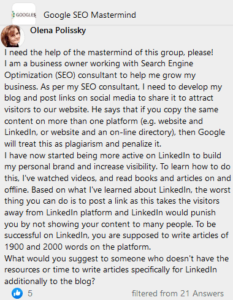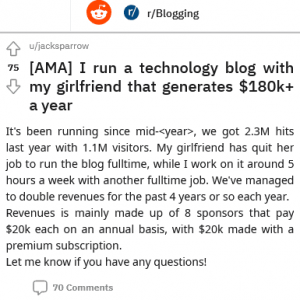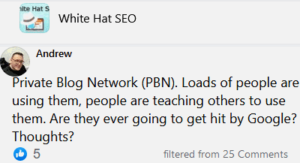Case study: 8 LinkedIn tactics that really worked for us-and 5 that didn't
About a year ago, my boss suggested that we concentrate our Business-to-Business (B2B) content marketing efforts on LinkedIn. Since the social network was just transforming into a powerful content platform, the suggestion seemed more or less logical, so I had no objections though I didn't know anything about the platform-neither as a user, nor as a content marketer.
Of course, like other managers, I had a profile on LinkedIn, but almost never logged in on the website. Practice makes perfect, I said to myself. How different can it be from things I do know like Facebook or Instagram? Let's start something-and will figure it out by trial and error.
Now our reach on LinkedIn amounts to around 100,000 views a day and we have zillions of followers… If you expect to read something like that after such a preface, you are better off reading something else. This isn't a post that promises miracles-and ends with a link to a 399-dollar "course on content marketing on LinkedIn."
We did achieve some solid results that have made LinkedIn the key element of our content marketing strategy, and my goal here is simply to share what we've learned so far and maybe inspire you to share your insights in turn.
1. Building CEO's profile instead of the brand's-WORKS!
I noticed that many company pages on LinkedIn with tens of thousands of followers get only a few likes on their posts. At the same time, some ordinary guy from Mississippi with only a thousand followers can enjoy a ten times higher engagement rate.
This makes sense: social media are about people, not about brands. So from day one, I decided to focus on growing the Chief Executive Officer (CEO)/founder's profile instead of the company's. This was a right choice: in a few weeks, we already saw dozens of likes and thousands views on his updates.
2. Growing your network through professional groups-WORKS!
A year ago, the CEO had a network that was pretty random and outdated. So under his account, I joined a few groups of professionals and started sending out invitations to connect.
Every day, I would go through the list of the group's members and add 10-20 new contacts. This was bothersome, but necessary at the beginning. Soon, LinkedIn started suggesting relevant contacts by itself, and I could opt out of this practice.
3. Sending out personal invites-WORKS! (kind of)
LinkedIn encourages its users to send personal notes with invitations to connect. I tried doing that, but soon found this practice too time-consuming. As a founder of 200-million fast-growing brand, the CEO already saw a pretty impressive response rate. I suppose many people added him to their network hoping to land a job one day.
What I found more practical in the end was sending a personal message to the most promising contacts AFTER they have agreed to connect. This way I could be sure that our efforts weren't in vain. People we reached out personally tended to become more engaged. I also suspect that when it comes to your feed, LinkedIn prioritize updates from contacts you talked to.
4. Keeping the account authentic-WORKS!
I believe in authenticity: it is crucial on social media. So from the get-go, we decided not to write anything FOR the Chief Executive Officer (CEO). He is pretty active on other platforms where he writes in his native language.
We pick his best content, adapt it to the global audience, translate in English and publish. I can't prove it, but I'm sure this approach contributed greatly to the increase of engagement on his LinkedIn account. People see that his stuff is real.
5. Using the CEO account to promote other accounts-WORKS!
The problem with this approach is that I can't manage my boss. If he is swamped or just doesn't feel like writing, we have zero content-and zero reach. Luckily, we can still use his "likes."
Today, LinkedIn is a unique platform-like Facebook in its early years. When somebody in your network likes a post, you see this post in your feed even if you aren't connected with its author.
So we started producing content for our top managers and saw almost the same engagement as with the CEO's own posts because we could reach the entire CEO's network through his "likes" on their posts!
6. Publishing video content-DOESN'T WORK
I read million times that video content is killing it on social media and every brand should incorporate videos in its content strategy. We tried various types of video posts but rarely managed to achieve satisfying results.
With some posts our reach was higher than the average but still, it couldn't justify the effort (making even home-made-style videos is much more time-consuming than writings posts).
7. Leveraging slideshows-WORKS! (like hell)
We found the best performing type of LinkedIn content almost by accident. As many companies do, we make lots of slideshows, and some of them are pretty decent, with tons of data, graphs, quotes, and nice images. Once, we posted one of such slideshow as PDF-and its reach skyrocketed!
It wasn't actually an accident-every time we posted a slideshow the results were much better than our average reach. We even started creating slideshows specifically for LinkedIn-with bigger fonts so users could read the presentation right in the feed, without downloading it or making it full-screen.
8. Adding links to the slideshows-DOESN'T WORK
I tried to push the slideshow thing even further and started adding links to our presentations. My thinking was that somebody do prefer to download and see them as PDFs-in this case, links would be clickable. Also, I made shortened urls, so they were fairly easy to be typed in.
Nobody used these urls in reality.
9. Driving traffic to a webpage-DOESN'T WORK
Every day I see people who just post links on LinkedIn and hope that it would drive traffic to their websites. I doubt it works. Any social network punishes those users who try to lure people out of the platform. Posts with links will never perform nearly as well as posts without them. This rule stays true on LinkedIn.
I tried different ways of adding links-as a shortlink, natively, in comments… It didn't make any difference and I couldn't turn LinkedIn into a decent source of traffic for our own webpages.
On top of how algorithms work, I do think that people simply don't want to click on anything in general, they WANT to stay on LinkedIn.
10. Publishing content as LinkedIn articles-DOESN'T WORK
LinkedIn limits the size of text you can publish as a general update. Everything that exceeds the limit of 1300 characters should be posted as an "article."
I expected the network to promote this type of content (since you put so much effort into writing a long-form post). In reality articles tended to have as bad a reach/engagement as posts with external links. So we stopped publishing any content in the form of articles.
It's better to keep updates under the 1300 character limit. When it's not possible, adding links makes more sense-at least you'll drive some traffic to your website. Yes, I saw articles with lots of likes/comments but couldn't figure out how some people managed to achieve such results.
11. Growing your network through your network-WORKS!
When you secure a certain level of reach, you can start expanding your network "organically"-through your existing network. Every day I go through the likes and comments on our updates and send invitations to the people who are
• from the CEO's 2nd/3d circle and
• fit our target audience.
Since they just engaged with our content, the chances that they'll respond to an invite from the CEO are pretty high. Every day, I also review new connections, pick the most promising person (CEOs/founders/consultants) and go through their network to send new invites. LinkedIn even allows you to filter contacts so, for example, you can see people from a certain country (which is quite handy).
12. Leveraging hashtags-DOESN'T WORK (yet)
Now and then, I see posts on LinkedIn overstuffed with hashtags and can't wrap my head around why people do that. So many hashtags decrease readability and also look like a desperate cry for attention. And most importantly, they simply don't make that much difference.
I checked all the relevant hashtags in our field and they have only a few hundred followers, sometimes no more than 100 or 200. I still add one or two hashtags to a post occasionally hoping that at some point they might start working.
For now, LinkedIn isn't Instagram when it comes to hashtags.
13. Creating branded hashtags-WORKS (or at least makes sense)
What makes more sense today is to create a few branded hashtags that will allow your followers to see related updates. For example, we've been working on a venture in China, and I add a special hashtag to every post covering this topic.
—
As of now, the Chief Executive Officer (CEO) has around 2,500 followers. You might say the number is not that impressive, but I prefer to keep the circle small and engaged. Every follower who sees your update and doesn't engage with it reduces its chances to reach a wider audience. Becoming an account with tens of thousands of connections and a few likes on updates would be sad.
We're in Business-to-Business (B2B), and here the quality of your contacts matters as much as the quantity. So among these 2,5000 followers, there are lots of CEOs/founders. And now our organic reach on LinkedIn varies from 5,000 to 20,000 views a week. We also receive 25-100 likes on every post. There are lots of people on LI who post constantly but have much more modest numbers.
We also had a few posts with tens of thousands views, but never managed to rank as the most trending posts on LinkedIn. This is the area I want to investigate. The question is how to pull this off staying true to ourselves and to avoid producing that cheesy content I usually see trending.
102 Best SEO Tips to Help You Drive Traffic
40 Tips Done for Getting 6,6M Monthly Organic Traffic for a SaaS Website





